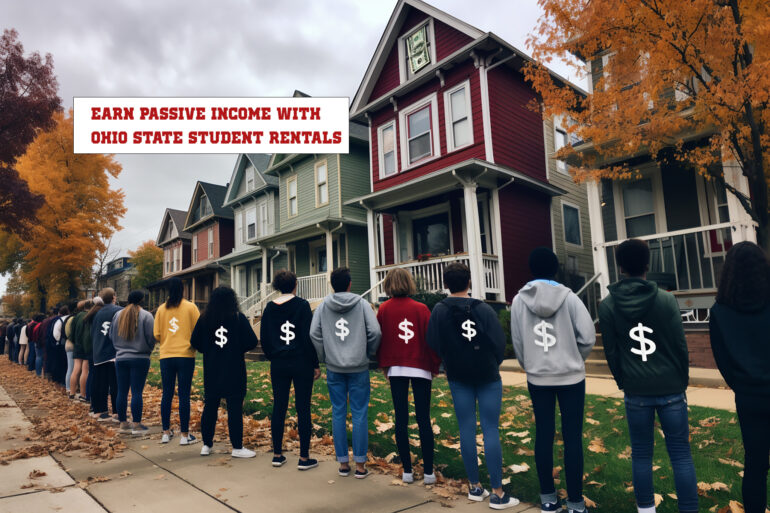How to Earn a Great Passive Income with Ohio State Student Rentals
Real estate investors have a variety of options: residential, commercial, undeveloped real property, real estate investment trusts, and more. Categories or niches, such as renting single-family or multi-family homes, flipping property, or vacation rentals, can help narrow an investor’s focus. Here, we will look at one distinctive opportunity—generating passive income from student rental units near the Ohio State University campus in Columbus, OH.
The single most important assessment involves accurately calculating the amount of your monthly rental income in comparison to your monthly expenses.
Defining the Goal or Purpose
What is passive income? This depends. The IRS defines it in two ways:
Income resulting from transactional or business activity that lacks material participation. Or, income generated from a non-real estate professional that results from rental activity regardless of the level of personal involvement or participation.
From this perspective, passive income is distinguished from active income, which results from traditional employment or business endeavors.
For our purposes, the term passive refers to rental property income generated without direct, day-to-day involvement. Further, this implies that you will use a local property manager. To achieve this goal, you must maintain a positive monthly cash flow.
The single most important assessment involves accurately calculating the amount of your monthly rental income in comparison to your monthly expenses.
Ways of Measuring Good or Bad Buying Opportunities
Understanding the 1% Rule
The 1% rule is a general assessment or guideline for evaluating an investment property. The rule states that the monthly rent generated must exceed 1% of the sale price of the property. For example, for a multi-unit rental property that costs $350,000, you must generate $3,500 in rent each month.
The purchase price should include any upfront repairs or improvements needed. Many investors recommend using a 2% rule instead, which provides more of a “buffer.”
The Gross Rent Multiplier (GRM)
The GRM is a general indicator of how many years it will take to pay off a property. The calculation divides the sale price by the gross yearly rent that is generated. For example, a property that costs $350,000 that generates $3,000 in rent each month or $36,000 a year has a 9.72 GRM. The GRM is useful in comparing potential property investments. Keep in mind that variables including the costs of repairs and maintenance and vacancy rates apply.
The Income Approach or Capitalization Rate
Potential buyers of a rental property might also consider using the income approach or capitalization (cap) rate assessment. The cap rate compares properties according to their net rental yield using the following formula:
Cap Rate = Net Operating Income (NOI) / Property Price (Value)
For example, let’s assume the property’s purchase price is $350,000 with a monthly gross rental income of 3,000 and estimate the average operating expenses as 36%.
NOI = 3,000 x 12 = $36,000 – 36% ($12,960) = $23,040
Cap Rate = $23,040 / $350,000 = 6.5%
Higher cap rates generally equate to better-quality investments. As a rule of thumb, cap rates in the 8% to 12% range are good.
Other potentially helpful tools or rules for assessing rental property investments include the sales comparison (comp) model, the capital asset pricing model (CAPM), and more.
University data estimates that annual undergraduate enrollment is roughly 47,000 and graduate enrollment is approximately 14,000.
The General Advantages & Disadvantages of College Town Rental Properties
Advantages
- Strong demand: New students and faculty will enter the campus-area rental housing market each year.
- A large pool of prospective tenants: Aside from students, colleges have many employees, and many others work in the local campus economy.
- Parental co-signers: Compared to other prospective tenants, college students will likely have limited credit, employment, and rental histories. While this initially appears as a major drawback, parental co-signers usually make it a positive. The parents of college students are typically middle-aged and will act as co-signers in support of their children’s education.
- Dispersed or “diversified” risk: For example, in a campus housing rental, your three-bedroom unit might have three separate rental agreements for each student (or their parents). In a single-family, three-bedroom home, you may have one adult (breadwinner) assuming full responsibility for the rent. In the latter example, a loss of employment might result in zero rental income.
Disadvantages
- Increased risk of property damage: College students are young adults that often lack maturity and demonstrate carelessness.
- Disagreements and disruptions: Bringing together multiple roommates often generates conflicts and these young tenants are more likely to host raucous parties that generate noise complaints.
- Tenant turnover: You should expect to need new tenants every year. Some students leave campus during the summer months and prefer nine-month or other shorter-term leases.
The aforementioned disadvantages reinforce the importance of having a diligent “hands-on” property manager.
Specific Market Analysis: The Ohio State University’s Main Campus
University data estimates that annual undergraduate enrollment is roughly 47,000 and graduate enrollment is approximately 14,000. Further, there are about 36,000 non-student employees. The University requires that all unmarried students who are enrolled full-time live on campus for the first two years.
The following table contains examples of current rental unit prices using the Ohio State University off-campus housing finder.
| Summary / Property Description | Rental Pricing |
| 1 bedroom in a private home | $725 |
| 2 bedrooms in a private home, 1 full bath | $1,200 |
| 2 bedroom apartment, 1 full bath, 1 half bath | $1,400 |
| 3 bedroom house, 1 full bath | $1,650 |
| 3 bedroom house, 2 full baths | $2,125 |
According to the Building Industry Association (BIA) of Central Ohio, to accommodate the region’s growing population, more than 100,000 new housing units will be necessary for this decade. Thus far in 2023, home prices in the region are roughly 6.5% higher than the previous year. On a national level, mortgage interest rates remain high at approximately 6.75%, which suggests that now might not be a good time to buy.
What Rental Features Appeal to Prospective Student Tenants?
Affordability is an important factor among most prospective tenants; however, based on the similarities among alternatives, remaining competitively priced within the market is likely of greater importance.
The properties located closest to the campus are likely more sought after, as a lack of parking encourages many students to walk or ride bicycles, etc.
Evaluating these opportunities requires some diligence on a case-by-case basis.
Other Key Financial Variables for Rental Property Investors
With interest rates well-above average, those considering a rental property purchase must identify other related expenses. Annual public records make estimating your potential property taxes fairly simple.
Ohio’s average annual homeowner’s insurance premium is approximately $1,100, which represents roughly a 20% savings versus the national average. Keep in mind that policies for landlords may fluctuate or have certain exclusions that require some research.
Property management costs, maintenance, repairs, and utilities are all potentially major financial variables that must also be determined. In central Ohio, the rates that property managers charge varies considerably, based on the scope of services provided.
The Ohio State University’s Off-Campus Housing Network connects students with potential rental housing options. It appears to be a very active, viable resource for landlords who comply with the University’s safety requirements.
Conclusion / Summary
Motivated real estate investors should consider buying rental properties to house Ohio State University students in Columbus. What is an ideal rental property for these purposes? Evaluating these opportunities requires some diligence on a case-by-case basis. There are a host of financial variables involved, such as purchase price, rent, mortgage interest, tax considerations, and many more. The key is to identify opportunities that will provide a positive monthly cash flow and remain a long-term source of passive income.
Anthony (Tony) Amodeo is a seasoned content writer for clients operating in markets including real estate, consumer finance, healthcare, and facility management. Residing in Northeast Ohio, he is a graduate of Kent State University.








